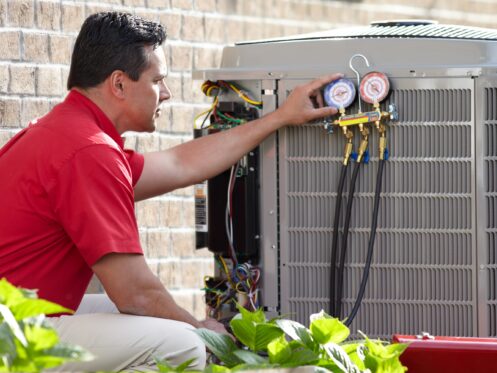Even though the air conditioner in your Billings, MT home is running, this doesn’t mean that it’s doing its job. Despite turning on and making gentle, humming sounds, some air conditioners are only able to produce hot air. If the air coming out of your vents is anything but cold, it’s important to find out why. The following are seven common causes of this problem.
- You Haven’t Changed Your HVAC Air Filter in a While
- There Are Airflow Problems in Other Areas
- The Evaporator Coil Is Dirty
- There’s a Refrigerant Leak
- There Are Algal Blooms in the Condensate Drain
- It’s Time to Repair or Replace Leaky Air Ducts
- The Condenser Coil Needs Cleaning
1. You Haven’t Changed Your HVAC Air Filter in a While
Many common AC issues start at the air filter. If this component ever becomes riddled with debris, airflow throughout the entire cooling system will falter. Air conditioners work harder when their filters are dirty. They have to use more energy to push air through clogged filter mesh, and they struggle to regulate humidity. They produce and circulate a lot less cold air.
If a dirty air filter is the source of your problem, putting a new one in won’t just lead to cooler temperatures. It will also prevent your AC from overheating and from sustaining serious, stress-related damage, most likely requiring an AC repair.
2. There Are Airflow Problems in Other Areas
Even if your HVAC air filter is clean, there may be build-ups of lint-like debris that are affecting airflow in other areas. A great place to check is at your HVAC air vents. You can remove accumulations of dirt, dust, and other allergens and contaminants using a damp cloth. If there are build-ups behind these features, use a screwdriver to unscrew your vent covers and clean them.
You should also check your outside condenser unit for accumulations of debris around its perimeter. To ensure optimum airflow, this unit should have two feet of clearance all around.
3. The Evaporator Coil Is Dirty
Your air conditioner’s evaporator coil is located in the indoor air handler. If there is a refrigerant leak, this component could be coated in small drops of coolant that look a lot like champagne bubbles. Even when refrigerant leaks don’t exist, this component is prone to developing coatings of dust, hair, and other grime. During your annual AC tune-up service, both the indoor evaporator coil and the outside condenser coil are cleaned. If you’ve skipped this service, this is likely why your air conditioner is blowing out warm air rather than air that actually feels cold.
When warm air passes over a properly functioning evaporator coil, the chilled refrigerant it contains absorbs its heat. Coatings of dirt and grime affect this heat transfer process. This results in warm or tepid air being passed back into the home.
4. There’s a Refrigerant Leak
Refrigerant is the lifeblood of air conditioners. The AC compressor pushes refrigerant throughout the system so that it can absorb and release heat as needed. When refrigerant leaks develop, air conditioners have increasingly less coolant to work with and an increasingly difficult time producing cold air. Worse still, any dramatic decline in refrigerant levels can cause AC compressors to collapse and outright fail. If you suspect that your air conditioner is leaking refrigerant, schedule service right away.
5. There Are Algal Blooms in the Condensate Drain
When you turn your air conditioner off at the end of summer, its condensate drain line and drain pan might not be completely dry. Even modest amounts of moisture in either of these areas can give way to the proliferation of algae or algal blooms. These blooms block condensate drain lines and affect overall AC performance. Condensate line blockages can also occur as the result of bacterial growths, dirt, and other debris. If your condensate line is blocked, we can clear it during your AC tune-up service.
6. It’s Time to Repair or Replace Leaky Air Ducts
HVAC air ducts are expected to last between 10 and 15 years. If you haven’t replaced these features in two decades or more, there’s a high likelihood that they’re leaking. Leaky air ducts deposit cooled air behind drywall or in basement areas and crawlspaces. This air has virtually no impact on indoor temperatures. Moreover, it can account for as much as 50% of a home’s energy waste.
Unfortunately, leaky air ducts can also take warm air in. If you have warm air blowing out of your air ducts, this is likely air that’s been extracted from unserviced areas of the building. It’s also completely unfiltered. Thus, not only is your indoor temperature remaining fairly static despite the fact that your air conditioner is running, but your indoor air quality (IAQ) is steadily declining.
7. The Condenser Coil Needs Cleaning
Skipping annual AC tune-up service can also leave you with a dirty condenser coil. Unlike the evaporator coil that’s located inside of your house, this coil is at the building exterior in your air conditioner’s condenser/compressor unit. The chilled refrigerant in the evaporator coil absorbs heat from the indoor air. The condenser coil is where this heat is released. If it’s too dirty to do its job properly, heat transfer will suffer and your indoor temperature will rise.
We’ve been proudly serving residents of Billings, MT since 1983. We offer heater, heat pump, and air conditioner installation, maintenance, and repair services. We also provide ductless mini-splits, IAQ services, and fireplaces. To schedule AC repairs, contact Comfort Heating & Air Conditioning, LLC now.


